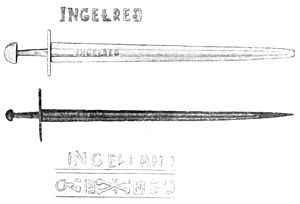


The Ingelrii group consists of about 20 known[1] medieval swords from the 10th to 12th century with a damascening blade inscription INGELRII, appearing with several slight spelling variations such as INGELRD and INGELRILT.[2] It is comparable to the older, much better-documented Ulfberht group (9th to 11th century, about 170 known examples).
By 1951, Ewart Oakeshott had originally identified thirteen such swords of this inscription, and had suggested that another, at Wisbech Museum, found in the river bed of the Old Nene in 1895, is also an Ingelrii; supported by Davidson as a possible fourteenth.[2]
Other variations of the inscription have also been found: INGRLRIIMEFECIT on a sword found by Sigridsholm,[2][3] Sweden, and INGELRIH FECIT on a sword found in Flemma, Norway.[2]
This article relating to swords is a stub. You can help Wikipedia by expanding it. |
This article related to the history of England is a stub. You can help Wikipedia by expanding it. |